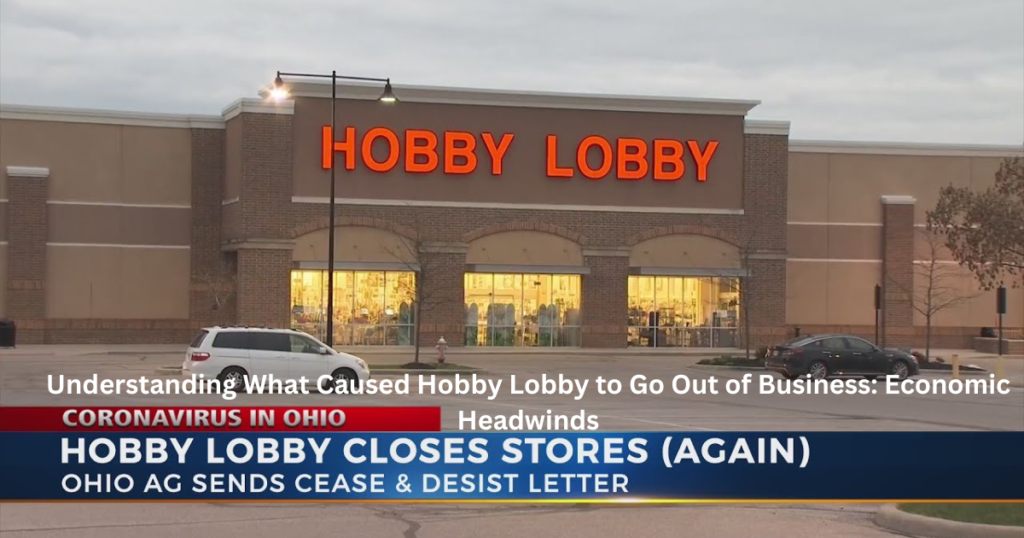Along the main streets of towns all over the United States, Hobby Lobby has been more than just a store for a long time. It’s been a place of community, motivation, and art. Hobby Lobby has changed the way people shop forever. It started as a small picture frame business in a closet and has grown into one of the most significant arts and crafts stores in the country. Even though Hobby Lobby has a long past and a lot of loyal customers, it recently made the sad news that it’s closing. Many people are confused about what went wrong and sorry about the loss of a beloved institution after this news came out. We will look at the economic, social, and cultural factors that led to the demise of Hobby Lobby in this in-depth study of the company’s rise and fall.
Table of Contents
ToggleHow Hobby Lobby Grew from a Small Store to a Retail Giant

A Wish for a Family
In 1972, David Green and his family set out to follow their business dreams. This is where the story of Hobby Lobby starts. The Green family’s garage business, which began as a small picture frame shop, quickly grew into something much bigger. Hobby Lobby promptly became popular in the area by focusing on selling high-quality items and providing excellent customer service.
A Plan for Growth
As the years went by, Hobby Lobby’s goals grew beyond its small beginnings. When the business opened its first store in 1972, it sold a lot of arts, crafts, and home decor items. With every new store that opened, Hobby Lobby’s reach grew, and its excellent image kept spreading.
Putting together a brand
One of the best things about Hobby Lobby was that it could connect with people on a deeper level. The company made itself stand out in the retail world by embracing Christian ideals and selling a wide range of goods. Hobby Lobby wanted to be a one-stop shop for all of its customers, whether they were looking for art tools, home decor, or religious items.
Challenges and Controversies: How to Get Through Tough Legal Battles

As successful as Hobby Lobby was, it had its share of problems along the way. The company got into a legal fight with the U.S. government in 2014 over whether to cover birth control for its workers. The case went all the way to the Supreme Court because Hobby Lobby didn’t like some types of birth control for religious reasons. Even though the business won, the controversy caused a lot of debate and could have hurt its reputation.
Changing The Waves
While Hobby Lobby was growing, the market changed in ways that made it harder to do things. E-commerce and internet shopping have become very popular, which is a big problem for traditional stores. As more people chose to shop online for comfort and variety, Hobby Lobby had to deal with more competition and pressure to change with the times.
Understanding What Caused Hobby Lobby to Go Out of Business: Economic Headwinds

The COVID-19 outbreak caused the economy to slow down, which was one of the main things that hurt Hobby Lobby. Like many other stores, Hobby Lobby had problems with their supply chains, less foot traffic, and higher running costs. As people tightened their belts and put more emphasis on buying things they needed, they spent less on arts and crafts materials, which hurt Hobby Lobby’s bottom line.
Problems with technology
The massive shift in customer behavior toward shopping online was another big problem for Hobby Lobby. Many shoppers have chosen to shop from the comfort of their own homes instead of going to stores because e-commerce platforms and digital markets are so convenient. Hobby Lobby tried to improve its online presence, but it still needed to compete with the speed, range, and ease of use that online stores offered.
The News: A Sad Farewell

The Choice to Close
Because problems were getting worse and recovery seemed less likely, Hobby Lobby had to make the hard choice to shut down for good. People who work in stores and customers who bought things were both shocked by the news. Hobby Lobby was more than just a shop to many people; it was an essential part of their lives and a symbol of creativity and community.
What Happens to Communities
The communities that Hobby Lobby shops serve will be affected in many ways by the closing of those stores. Aside from the jobs and businesses that will be lost, many customers are sad about the end of an era and the loss of a known landmark. Hobby Lobby’s closing creates a hole that might never be filled, showing the more significant problems that traditional stores are facing in a world that is becoming more and more digital.
Conclusion:
As we think about Hobby Lobby’s rise and fall, we can learn essential lessons from its story. Retail is constantly changing, so companies need to be quick to respond and change with the times to stay in business. Hobby Lobby’s closing is sad for its loyal customers and hardworking workers. Still, it’s also a stark reminder of how important it is to be creative, resilient, and ahead of the curve in a world that is constantly changing.
As we say goodbye to Hobby Lobby, let’s remember the good times we had there and look forward to the future with hope and positivity. This part of Hobby Lobby’s past may be coming to an end, but the creativity and sense of community it fostered will live on in the hearts of those who loved it the most.
Source:
Retail Sales Data from the U.S.





















